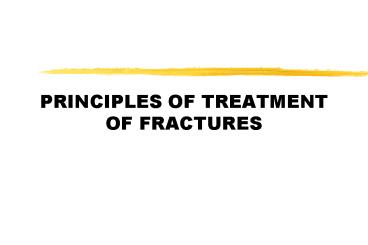PRINCIPLES OF TREATMENT OF FRACTURES - PowerPoint PPT Presentation
1 / 27
Title:
PRINCIPLES OF TREATMENT OF FRACTURES
Description:
PRINCIPLES OF TREATMENT OF FRACTURES GOALS OF FRACTURE TREATMENT Restore the patient to optimal functional state Prevent fracture and soft-tissue complications Get ... – PowerPoint PPT presentation
Number of Views:433
Avg rating:3.0/5.0
Title: PRINCIPLES OF TREATMENT OF FRACTURES
1
PRINCIPLES OF TREATMENT OF FRACTURES
2
GOALS OF FRACTURE TREATMENT
- Restore the patient to optimal functional state
- Prevent fracture and soft-tissue complications
- Get the fracture to heal, and in a position which
will produce optimal functional recovery - Rehabilitate the patient as early as possible
3
HOW FRACTURES HEAL
- In nature
- Regeneration vs repair
- Three phases of healing by callus
- Rapid process, rehabilitation slow, low risk
- With operative intervention (reduction
compression) - Primary bone healing
- Slow process, rehabilitation rapid, high risk
- With operative intervention (nailing or external
fixation) - Healing by callus
- Rapid process, rehabilitation rapid, lesser risk
4
FACTORS AFFECTING FRACTURE HEALING
- The energy transfer of the injury
- The tissue response
- Two bone ends in opposition or compressed
- Micro-movement or no movement
- BS (scaphoid, talus, femoral and humeral head)
- NS
- No infection
- The patient
- The method of treatment
5
HIGH-ENERGY INJURY
6
LOW ENERGY INJURY
7
DESCRIBING THE FRACTURE
- Mechanism of injury (traumatic, pathological,
stress) - Anatomical site (bone and location in bone)
- Configuration Displacement
- three planes of angulation
- translation
- shortening
- Articular involvement/epiphyseal injuries
- fracture involving joint
- dislocation
- ligamentous avulsion
- Soft tissue injury
8
MINIMALLY DISPLACED DISTAL RADIUS FRACTURE
9
COMMINUTED PROXIMAL- THIRD FEMORAL FRACTURE WITH
SIGNIFICANT DISPLACEMENT
10
MANAGEMENT OF THE INJURED PATIENT
- Life saving measures
- Diagnose and treat life threatening injuries
- Emergency orthopaedic involvement
- Life saving
- Complication saving
- Emergency orthopaedic management (Day 1)
- Monitoring of fracture (Days to weeks)
- Rehabilitation treatment of complications
(weeks to months)
11
LIFE SAVING MEASURES
- A Airway and cervical spine immobilisation
- B Breathing
- C Circulation (treatment and diagnosis of cause)
- D Disability (head injury)
- E Exposure (musculo-skeletal injury)
12
EMERGENCY ORTHOPAEDIC MANAGEMENT
- Life saving measures
- Reducing a pelvic fracture in haemodynamically
unstable patient - Applying pressure to reduce haemorrhage from open
fracture - Complication saving
- Early and complete diagnosis of the extent of
injuries - Diagnosing and treating soft-tissue injuries
13
(No Transcript)
14
DIAGNOSING THE SOFT TISSUE INJURY
- Skin
- Open fractures, degloving injuries and ischaemic
necrosis - Muscles
- Crush and compartment syndromes
- Blood vessels
- Vasospasm and arterial laceration
- Nerves
- Neurapraxias, axonotmesis, neurotmesis
- Ligaments
- Joint instability and dislocation
15
SEVERE SOFT-TISSUE INJURY
16
TREATING THE SOFT TISSUE INJURY
- All severe soft tissue injuriesequire urgent
treatment - Open fractures , Vascular injuries, Nerve
injuries, Compartment syndromes,
Fracture/dislocations - After the treatment of the soft tissue injury the
fracture requires rigid fixation - A severe soft-tissue injury will delay fracture
healing
17
DIAGNOSING THE BONE INJURY
- Clinical assessment
- History
- Co-morbidities
- Exposure/systematic examination
- First-aid reduction
- Splintage and analgesia
- Radiographs
- Two planes including joints above and below area
of injury
18
TREATING THE FRACTURE I
- Does the fracture require reduction?
- Is it displaced?
- Does it need to be reduced? (e.g. clavicle, ribs,
MTs) - How accurate a reduction do we need?
- alignment without angulation (closed reduction -
e.g. wrist) - anatomic (open reduction - e.g. adult forearm )
19
(No Transcript)
20
(No Transcript)
21
TREATING THE FRACTURE II
- How are we going to hold the reduction?
- Semi-rigid (Plaster)
- Rigid (Internal fixation)
- What treatment plan will we follow?
- When can the patient load the injured limb?
- When can the patient be allowed to move the
joints? - How long will we have to immobilise the fracture
for?
22
DIFFERENT TYPES OF RIGID FRACTURE FIXATION
23
TREATING THE FRACTURE III
- Operative Non-optve
- Rehabilitation Rapid Slow
- Risk of joint stiffness Low Present
- Risk of malunion Low Present
- Risk of non-union Present Present
- Speed of healing Slow Rapid
- Risk of infection Present Low
- Cost ? ?
24
INDICATIONS FOR OPERATIVE TREATMENT
- General trend toward operative treatment last 30
yrs - Improved implants and antibiotic prophylaxis, Use
of closed and minimally invasive methods - Current absolute indications-
- Polytrauma Displaced intra-articular fractures
- Open s s with vascular inj or compartment
syn, Pathological s Non-unions - Current relative indications-
- Loss of position with closed method, Poor
functional result with non-anatomical reduction,
Displaced fractures with poor blood supply,
Economic and medical indications
25
WHEN IS THE FRACTURE HEALED?
- Clinically
- Upper limb Lower limb
- Adult 6-8 weeks 12-16 weeks
- Child 3-4 weeks 6-8 weeks
- Radiologically
- Bridging callus formation
- Remodelling
- Biomechanically
26
REHABILITATION
- Restoring the patient as close to pre-injury
functional level as possible - May not be possible with-
- Severe fractures or other injuries
- Frail, elderly patients
- Approach needs to be-
- Pragmatic with realistic targets
- Multidisciplinary
- Physiotherapist, Occupational therapist, District
nurse, GP, Social worker
27
COMPLICATIONS OF FRACTURES
- Early Late
- General Other injuries Chest infection
- PE UTI
- FES/ARDS Bed sores
- Bone Infection Non-union
- Malunion
- AVN
- Soft-tissues Plaster sores/WI Tendon rupture
- N/V injury Nerve compression
- Compartment syn. Volkmann contracture

